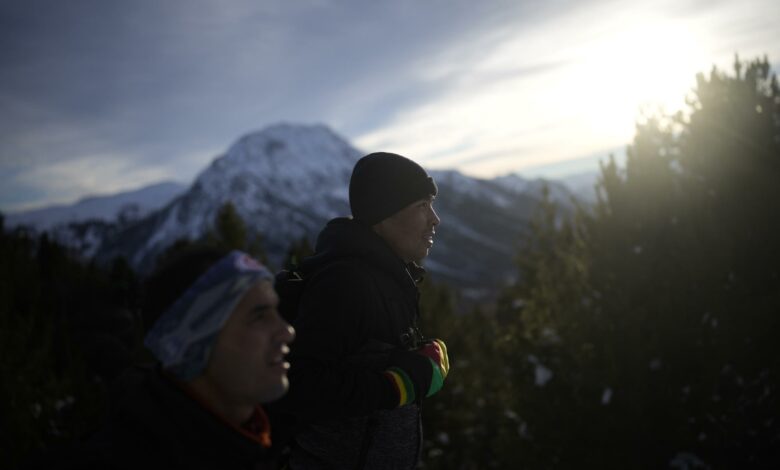
CLAVIERE, Italy (AP) — When suicide attackers and gunmen massacred crowds flocking to Kabul’s airport, they also severed the escape route that Ali Rezaie hoped would take him to a new life abroad, far from the Taliban and their suspicions of well-educated, middle-class people who worked with foreigners in Afghanistan.
In the chaos, Rezaie couldn’t reach the airport where flight after flight took off without him. The 27-year-old was left with no choice but to take his future into his own leathery hands. Like many other Afghans, he resolved to find another way out and embarked on a forbidding journey of thousands of kilometers to Europe, large parts of it on foot.
More than three months later, Rezaie’s odyssey through five countries has carried him high into the French-Italian Alps, where he is pushing through knee-deep snow to evade border guards, with a journalist from The Associated Press in tow.
The Afghan exodus that some feared would flood Europe with migrants after the Taliban swept to power hasn’t materialized. And amid the toothy Alpine crags bristling with icicles, it quickly becomes apparent why: Only the hardiest, most driven and most resourceful exiles make it this far.
Ahead of Rezaie in the snowscape is the French border, unmarked but guarded around the clock by police who peer through thermal binoculars for heat signatures. Rezaie’s companion, another Afghan bearing scars from a suicide bombing that prompted him to flee, had already tried — and failed — to reach France via this wintry route.
So the Afghans advance carefully. They pause to listen for sounds in the frozen silence, to consult a map on Rezaie’s phone before the chill kills its battery and to munch on jam-filled croissants they bought in the frontier village of Claviere in Italy. If caught by French guards patrolling the border on foot, ski-bikes and in vans, Italy is where they’ll be forced to return.
The Taliban takeover and the swift collapse of Afghanistan’s economy has sent people streaming illegally into neighboring Iran, which is often the first stepping stone for Afghans — including Rezaie — who push on into the European Union.
Afghans are now on course to overtake Syrians as Europe’s leading asylum-seekers in 2021. Internal EU reporting on migration trends shows that more than 80,000 Afghans applied for asylum through November. That’s a surge of 96% over the same span last year, and the increase was partly driven by the evacuations from Kabul airport.
Rezaie, from Herat in western Afghanistan, says he traveled to Kabul in search of a flight but then doubled back after the suicide bomb and gun attack in the waning days of the airlift. He believes he would have been killed had he stayed in Afghanistan because of work he did with foreign aid groups.
So he emptied out his savings, borrowed money and left behind his printing company, friends and comfortable life.
The quest took him first to Iran and Turkey, then onward by boat and for 25 days on foot into Greece. Next came Italy and then the French border.
Rezaie figures that crossing it will be easy, compared to all he’s been through. But it’s easier still for the European vacationers he suddenly encounters on a ski run that crosses his mountain path. They zoom past, paying him no heed, not having to worry about police patrols.
Feeling conspicuous on the manicured slope, Rezaie is struck by how sharply their carefree joy contrasts with his urgent need to get back in the camouflage of trees.
“Some people go down happy,” he says, lungs heaving in the thin air. “Other people go up sad.”
By finding paths deep into Europe, Rezaie and other migrants offer hope to those sure to follow. Their knowledge about the obstacles, their contacts and their travel tips will trickle back to Afghanistan. Migrants attempting the Alpine crossing share phone maps with GPS markers pointing the way.
Rezaie is aiming for the fortified French town of Briancon. Sayed and Mortaza, cousins and both 16, passed through Briancon hours earlier. They, too, fled in the days after Kabul fell and traveled through Iran to Turkey. From there, they were smuggled aboard a cramped boat to Italy, a brutal six-day voyage that left them too weak to stand.
Caught at the French border, they were allowed to continue because they are minors. Seven adult Afghans they crossed with were sent back.
The Taliban takeover scattered Sayed’s family. His father and older brother worked as police officers. They’ve fled, and Sayed thinks they’re hiding in Pakistan. Without their salaries, Sayed and his mother had no income, so they left, too. She is staying with a sister in Iran. He’s aiming for Germany.
“Maybe Dortmund, because I like Dortmund football club,” he said. “We just want to escape.”
Others who left long before the Taliban takeover say they no longer hope to return.
“It’s finished for us now, for everyone who is in Europe,” said Abdul Almazai, 26, who left Afghanistan as a teenager. Turned away at the French border with eight other Afghans, he planned to try again.
“We have crossed so many mountains,” he said. “I have to make my future.”
Aid workers worry that Afghans more accustomed to mountains and winter’s perils are taking riskier routes through the snow than migrants from warmer climes.
“They are confident, and sometimes being confident is not helpful,” said Luca Guglielmetto, a volunteer worker at a refuge on the Italian side that equips migrants with warm clothes and boots for the crossing.
With darkness falling, the battery on Rezaie’s phone dies. He and his companion forge on through the snow.
Rare are those who manage to cross on their first attempt. Rezaie pulled off that feat and glowed with pride the next morning as he tucked into breakfast at a refuge for migrants in Briancon.
He sent a video of himself wading through snow to his mother and brother in Iran.
He has his sights set on Germany. But he hopes one day to go home.
“I had a car. I had a job, work.” he said. “I had a good life.”
___
Follow AP’s global migration coverage at https://apnews.com/hub/migration

























